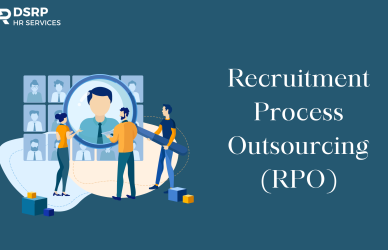In today’s competitive business landscape, employee retention is more crucial than ever. High turnover rates can lead to significant costs, loss of institutional knowledge, and decreased morale among remaining staff. At DSRP HR Services, we understand that retaining top talent is essential for maintaining a productive and innovative workforce. This blog delves into effective employee retention strategies that every HR professional should know to create a supportive and engaging work environment.
The Importance of Employee Retention
Employee retention is not just about reducing turnover rates; it’s about fostering a loyal, motivated, and skilled workforce. High employee retention leads to:
-Cost Savings: Recruiting, hiring, and training new employees is expensive. Retaining existing employees saves on these costs and ensures that investments in training yield long-term benefits.
-Increased Productivity: Experienced employees understand their roles and the company’s operations, leading to higher efficiency and productivity.
– Improved Morale: Frequent turnover can negatively impact the morale of remaining employees. Stable teams are typically more satisfied and engaged.
– Better Customer Satisfaction: Continuity and experience among staff members can lead to better customer service, fostering loyalty and positive business outcomes.
Key Employee Retention Strategies
1. Competitive Compensation and Benefits
Offering competitive salaries and comprehensive benefits packages is foundational to employee retention. Regularly review and adjust compensation to match industry standards and ensure fairness. Benefits should extend beyond basic health insurance to include retirement plans, paid time off, wellness programs, and other perks that enhance the employee experience.
2. Career Development Opportunities
Employees are more inclined to remain with a company that invests in their professional growth, so it’s important to provide clear career paths and opportunities for advancement. Establish mentorship programs to help employees develop new skills and prepare for higher roles within the organization.
3. Positive Work Environment
Creating a positive and inclusive work environment is crucial for employee retention Create a culture where respect, inclusion, and collaboration are valued. Encourage open communication and ensure that employees feel heard and valued. Promote work-life balance by offering flexible working hours, remote work options, and regular breaks.
4. Recognition and Rewards
Recognising and rewarding employees for their hard work and achievements on a regular basis can have a significant effect on morale and job satisfaction. Implement recognition programs that celebrate milestones, accomplishments, and contributions. Rewards can range from monetary bonuses to public acknowledgment, additional time off, or personalized gifts.
5. Effective On boarding
A strong on boarding process sets the tone for an employee’s experience with the company. Ensure that new hires feel welcomed and supported from the start. Provide comprehensive training, assign mentors, and regularly check in to address any concerns. A positive on boarding experience can increase engagement and reduce early turnover.
6. Employee Engagement
Employees who are engaged are more likely to remain with their employer. Conduct regular employee engagement surveys to gauge satisfaction and identify areas for improvement. Use feedback to make decisions and involve employees in the process. Creating a sense of ownership and belonging can strengthen their commitment to the organization.
7. Leadership and Management
The importance of effective leadership lies in employee retention. Train managers to be supportive, communicative, and empathetic. Encourage them to build strong relationships with their teams and provide regular feedback. Employees are more likely to stay with an organization if they have a good relationship with their direct supervisors.
8. Transparent Communication
Transparency is a key factor in building trust and fostering a positive work culture. Keep employees informed about company goals, changes, and developments. Encourage open communication channels where employees can freely share their ideas and concerns. Transparency can reduce uncertainty and increase employees’ sense of security and engagement.
9. Work-Life Balance
Ensure that employees have a healthy work-life balance to avoid burnout and increase job satisfaction by encouraging them to take their vacations and breaks. Supporting employees in balancing their professional and personal lives can lead to higher retention rates.
10. Employee Feedback
Regularly seek feedback from employees through surveys, suggestion boxes, or one-on-one meetings. Actively listen to their concerns and take appropriate actions to address them. Demonstrating that the company values and acts on employee input can enhance loyalty and commitment.
Implementing Retention Strategies
Implementing these retention strategies requires a proactive and systematic approach. Here are some steps to get started:
1. Assess Current Retention Rates
Analyse your current turnover rates to identify trends and areas for improvement. Understanding why employees leave can help tailor your retention strategies more effectively.
2. Develop a Retention Plan
Create a comprehensive retention plan that outlines specific goals, strategies, and metrics for success. Ensure that this plan aligns with the overall business objectives and culture of the organization.
3. Engage Leadership
Engage senior leadership in retention efforts. Their support and involvement are crucial for driving the implementation of retention strategies across the organization.
4. Communicate with Employees
Clearly communicate your retention initiatives to employees. Let them know that their satisfaction and engagement are priorities for the company. Regularly update them on the progress and impact of these initiatives.
5. Monitor and Adjust
Regularly monitor the effectiveness of your retention strategies. Use metrics such as turnover rates, employee satisfaction scores, and engagement levels to assess progress. Be prepared to adjust your strategies based on feedback and changing needs.
Conclusion
Effective employee retention strategies are essential for building a stable and motivated workforce. By focusing on competitive compensation, career development, a positive work environment, recognition, and other key areas, organizations can reduce turnover and enhance employee engagement. At DSRP HR Services, we are dedicated to helping businesses implement these strategies and achieve long-term success.
Contact us today to learn more about how we can support your employee retention efforts and create a thriving workplace environment.
Email Id: info@dsrpjobs.com
Contact No.: 8080803153





